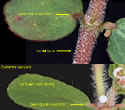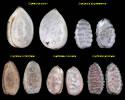Euphorbia maculata (Spotted Spurge)
| Also known as: | Prostrate Spurge, Spotted Sandmat |
|---|---|
| Genus: | Euphorbia |
| Family: | Euphorbiaceae (Spurge) |
| Life cycle: | annual |
| Origin: | native |
| Habitat: | sun; dry, sandy or gravelly soil; lawns, gardens, sidewalk cracks, waste areas, roadsides, railroads |
| Bloom season: | June - September |
| Plant height: | .25 to 4 inches |
| Wetland Indicator Status: | GP: FACU MW: FACU NCNE: FACU |
| MN county distribution (click map to enlarge): |  |
| National distribution (click map to enlarge): |  |
Pick an image for a larger view. See the glossary for icon descriptions.
Detailed Information
Flower: 

![[photo of flowers]](/udata/r9ndp23q/pd/euphorbia-maculata-80493-1-t.jpg) Flowers are small but distinct, in dense clusters in leaf axils on the upper side of spreading branches. A small cup, 1/8 inch across, holds the male and female flowers in the center.
Flowers are small but distinct, in dense clusters in leaf axils on the upper side of spreading branches. A small cup, 1/8 inch across, holds the male and female flowers in the center.
![[close-up of flowers]](/udata/r9ndp23q/pd/euphorbia-maculata-15-2-t.jpg) The rim of the cup has 4 white to pink, petal-like appendages with unevenly lobed edges and a thickened gland at the base that is green to red. The male flower anthers are yellow and nearly indistinct. The pistils of the single female flower in the center sit atop a round, three part ovary on a short stalk that extends out from the flower center. The structure of this flower is called a cyathium and common to all the Euphorbias.
The rim of the cup has 4 white to pink, petal-like appendages with unevenly lobed edges and a thickened gland at the base that is green to red. The male flower anthers are yellow and nearly indistinct. The pistils of the single female flower in the center sit atop a round, three part ovary on a short stalk that extends out from the flower center. The structure of this flower is called a cyathium and common to all the Euphorbias.
Leaves and stems: 

![[photo of leaves]](/udata/r9ndp23q/white/euphorbia-maculata-prostrate-hairy-spurge_0825_130810-t.jpg) Leaves are opposite, narrowly to broadly oblong, mostly between ¼ and 2/3 inch long and a third as wide. typically widest below the middle. Surfaces are sparsely covered with long hairs, denser on the underside, edges shallowly toothed, rounded or bluntly pointed at the tip, and strongly asymmetrical at the base.
Leaves are opposite, narrowly to broadly oblong, mostly between ¼ and 2/3 inch long and a third as wide. typically widest below the middle. Surfaces are sparsely covered with long hairs, denser on the underside, edges shallowly toothed, rounded or bluntly pointed at the tip, and strongly asymmetrical at the base.
![[photo of red-spotted leaves]](/udata/r9ndp23q/pd/euphorbia-maculata-7957983-5-t.jpg) Commonly there is a faint to prominent red splotch mid-leaf, but not always. Stems are up to 16 inches long, typically prostrate but occasionally ascending some, often reddish colored, sparsely to densely covered in spreading to ascending hairs, and branching frequently, forming large circular mats. Leaves and stems exude a milky sap when broken.
Commonly there is a faint to prominent red splotch mid-leaf, but not always. Stems are up to 16 inches long, typically prostrate but occasionally ascending some, often reddish colored, sparsely to densely covered in spreading to ascending hairs, and branching frequently, forming large circular mats. Leaves and stems exude a milky sap when broken.
Fruit: 
![[photo of fruit]](/udata/r9ndp23q/pd/euphorbia-maculata-853798-2-t.jpg) Fruit is a 3-lobed, stalked capsule, 1/10 inch wide, covered with short, soft appressed hairs. The capsule develops rapidly from the center of the cyathium, initially hanging down, becoming erect at maturity. Each lobe contains a single seed.
Fruit is a 3-lobed, stalked capsule, 1/10 inch wide, covered with short, soft appressed hairs. The capsule develops rapidly from the center of the cyathium, initially hanging down, becoming erect at maturity. Each lobe contains a single seed.
![[photo of seed]](/udata/r9ndp23q/pd/euphorbia-maculata-15-1-t.jpg) Seeds are white to light brown, 1 to 1.2 mm long, angular in cross-section, oval-oblong in outline, covered in minute pits on the surface with a few inconspicuous transverse ridges. It notably develops a mucous like coating when wet.
Seeds are white to light brown, 1 to 1.2 mm long, angular in cross-section, oval-oblong in outline, covered in minute pits on the surface with a few inconspicuous transverse ridges. It notably develops a mucous like coating when wet.
Notes:
Spotted Spurge collections seem to indicate it naturally favors sandy soils in association in riparian areas but it has become widely adapted to urban environments and is quite common and weedy throughout the metro and regional urban environments. Where found, it is frequently associated with the similar Ridge-seed Spurge (Euphorbia glyptrosperma) which is more widespread statewide. Characteristics that identify Spotted Spurge from other mat-forming Spurges are hairy stems; leaves that are hairy, finely serrated at least at the tip end, strongly asymmetrical at the base, mostly oblong and often (not always) have a red splotch in the middle; capsules covered in short, appressed hairs; seed lacking conspicuous ridges. The only other hairy, mat-forming Spurge known to be in Minnesota is Prostrate Spurge (Euphorbia prostrata), which has leaves more oval to egg-shaped and nearly symmetrical at the base, stem hairs are more curled than spreading, capsules with hairs mostly along the keels not the surface, and seed with conspicuous transverse ridges. The 3 other mat-forming Minnesota Spurges, Geyer's Spurge (Euphorbia glyptrosperma), Ridge-seed Spurge (Euphorbia glyptrosperma) and Thyme-leaved Spurge (Euphorbia serphillifolia), are all hairless. Spotted Spurge was formerly known as Chamaesyce maculata.
Native Plant Nurseries, Restoration and Landscaping Services ↓
More photos
 Spotted Spurge plant
Spotted Spurge plant Spotted Spurge plant
Spotted Spurge plant Spotted Spurge plants
Spotted Spurge plants “garden grown” Spotted Spurge
“garden grown” Spotted Spurge Euphorbia maculata with E. glyptosperma on a gravelly roadside
Euphorbia maculata with E. glyptosperma on a gravelly roadside stem hairs
stem hairs more leaves
more leaves close-up of fruit
close-up of fruit leaf/stem comparison of Euphorbia maculata and E. prostrata
leaf/stem comparison of Euphorbia maculata and E. prostrata fruit comparison of Euphorbia maculata and E. prostrata
fruit comparison of Euphorbia maculata and E. prostrata seed comparison of mat-forming Euphorbia species
seed comparison of mat-forming Euphorbia species
Photos by K. Chayka taken in Ramsey County. Photos courtesy Peter M. Dziuk taken in Anoka and Ramsey counties.
Comments
Have you seen this plant in Minnesota, or have any other comments about it?






